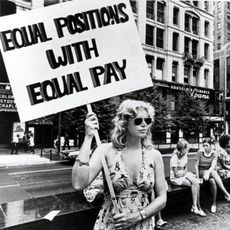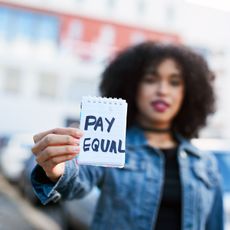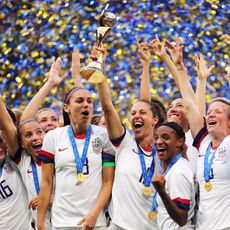Give Mom What She Really Wants This Year: Equal Pay
Mothers have faced some of the biggest setbacks since the pandemic started. So this year, don’t just say it with flowers—say it with phone calls to your Senators and your HR department.


A Pew Research report recently made headlines with a little good news for women: Young women are finally starting to out-earn young men in several U.S. cities. But tucked in that announcement was the still-bleak news that those positive headwinds didn’t extend to one group of women: mothers. While our culture heralds moms as the backbones of our communities, it's empty talk if it still doesn’t translate into pay equity for doing the same work as men, or even as women who aren’t moms.
In fact, moms are told to go right back to work after having babies so they don’t fall behind men, but women who become parents see their pay drop by 30 percent (and no joke, men see a 20 percent bonus for becoming parents).
And the raw numbers speak for themselves: Full-time working moms are paid, on average, 75 cents for every dollar dad makes, according to the National Women’s Law Center. When you drill down by race and ethnicity, it only gets worse: Latina mothers are paid 46 cents for every dollar paid to white, non-Hispanic fathers, while Black mothers are paid just 52 cents.
The old logic that women don’t need to be paid as much because men can be our breadwinners obviously doesn’t hold up, especially in light of the fact that women are more than four times as likely as men to be single parents supporting families.
So, instead of paying lip service to mothers this year, let’s focus on helping them get what they deserve. If we really want change, here’s what it’s going to take from private businesses, states, and the federal government:
Providing national paid family leave to all.
The best way for women to be able to keep earning—while also managing disproportionate care responsibilities for babies, kids, partners, and elders—is through paid family leave. Studies show new mothers who are able to take paid leave are more likely to stay in the workforce and are 54 percent more likely to see wage increases, compared to women who take no leave. (It would also help if more fathers were offered equal paid family leave and actually took it.)
Right now, the problem is access, because the people who would benefit the most (low-income women and women of color) are the least likely to have access to paid leave; less than 5 percent of America’s lowest-earning people can access such programs. And while women’s funds are pushing for changes at the state level, such as the Women’s Fund of Colorado’s advocacy that helped pass statewide 12-week paid family leave policy, we need a federal policy (come on, Build Back Better 2.0!) to ensure every woman can have a baby or take care of a sick relative without financial ruin, regardless of her zip code.
Stay In The Know
Get exclusive access to fashion and beauty trends, hot-off-the-press celebrity news, and more.
Allowing more flex/remote work.
The pandemic showed us just how grueling juggling work and home life can be. However, prior to the pandemic, moms often did that juggle with little or no acknowledgment of the added stress and strain. The pandemic finally made it impossible to ignore. One recent survey of more than 7,400 employees worldwide found that women with child care duties were 32 percent less likely to leave their job if they could work remotely. And this isn’t just about preference—it’s also about productivity.
Flexible work models have been shown to boost productivity and instill better work-life balance by more than 50 percent. Bottom line: If we say we truly support mothers in the workforce, we have to be willing to think outside the antiquated 9-5 framework that doesn’t work well for most moms. If you’re a manager, offer flexible schedules to your team, or you can write to your HR department to inquire about it, showing your company that there’s building demand and momentum for such policies.
Making child care more accessible and affordable.
The financial strain of child care on working families, moms in particular, is well documented. On average, families spend more than $8,000 per year per child for full-time childcare, and that number can rise sharply depending on where you live. This often creates a frustrating calculus, weighing if it’s financially reasonable to keep working or, instead, stay at home. What we need is federal funding to bridge the gap, but until that happens, some local efforts around the country are stepping up to provide solutions. Take, for example, the Iowa Women’s Foundation’s Building Community Child Care Solutions Fund, which funds local community, educational, and job training programs throughout the state to increase women’s economic security through access to quality, affordable child care. This way, women can pursue additional education and training without worrying how they’ll cover child care costs. It’s a trade-off no mom should have to make.
So this year, don’t just say it with flowers—say it with phone calls to your Senators and your HR department. By showing that whether we have kids or not, we stand together for moms, we can make sure mothers around the country get the respect (and paycheck) they’ve more than earned.
Elizabeth Barajas-Román is the President & CEO of the Women's Funding Network, the world’s largest philanthropic alliance for gender equity.
Elizabeth Barajas-Román is the President & CEO of the Women’s Funding Network, the largest philanthropic network in the world devoted to gender equity and justice. In this role, Elizabeth leads strategy to strengthen the collective power of the network as a unified platform for change.
-
 Susan Sarandon's Daughter Says 'Thelma & Louise Star' Was a Hardcore "Almond Mom"
Susan Sarandon's Daughter Says 'Thelma & Louise Star' Was a Hardcore "Almond Mom"She was very into health foods.
By Iris Goldsztajn Published
-
 Kristin Cavallari and Jason Statham Had a "Full-On Relationship" Not Just a "Hookup," Claims Source
Kristin Cavallari and Jason Statham Had a "Full-On Relationship" Not Just a "Hookup," Claims SourceInteresting!
By Iris Goldsztajn Published
-
 Jason Statham "Has Nothing to Say About" Kristin Cavallari Calling Him Her "Hottest Hookup," Source Claims
Jason Statham "Has Nothing to Say About" Kristin Cavallari Calling Him Her "Hottest Hookup," Source ClaimsOuch.
By Iris Goldsztajn Published
-
 Confronting Unequal Pay: A 10-Step Guide for Women—and Their Allies—to Fight Wage Discrimination
Confronting Unequal Pay: A 10-Step Guide for Women—and Their Allies—to Fight Wage DiscriminationBlack Women’s Equal Pay Day is not a celebration. My hope is that if we all continue to ask for what we want, we chip away at that wage gap, one Black woman—and ally—at a time.
By Minda Harts Published
-
 What Equal Pay Day Gets Wrong
What Equal Pay Day Gets WrongThe day marks how far into the year an average woman must work to earn what the average man earned the year prior. In her first finance column for Marie Claire, Sallie Krawcheck shares why Equal Pay Day also isn't measuring up.
By Sallie Krawcheck Published
-
 Today, Black Women’s Equal Pay Day, Illustrates Just How Much Black Women Are Undervalued and Underpaid
Today, Black Women’s Equal Pay Day, Illustrates Just How Much Black Women Are Undervalued and UnderpaidIn addition to the wage gap, new research from LeanIn.org shows that there are numerous "invisible" injustices as well.
By Megan DiTrolio Published
-
 America Deserves to Be Shamed by the U.S. Women's Soccer Team
America Deserves to Be Shamed by the U.S. Women's Soccer TeamWhat more do the four-time World Cup champions have to prove to get equal pay?
By Cady Drell Published
-
 Rejoice: You'll Get 20 Percent Off at These Retailers on Equal Pay Day
Rejoice: You'll Get 20 Percent Off at These Retailers on Equal Pay DayI guess it's something?
By Megan Friedman Published
-
 Audi's Super Bowl Ad Calls for Equal Pay—And a Lot of People Aren't Happy About That
Audi's Super Bowl Ad Calls for Equal Pay—And a Lot of People Aren't Happy About ThatSeriously? In 2017?
By Megan Friedman Published
-
 Why Female Doctors Are Paid So Much Less Than Their Male Counterparts
Why Female Doctors Are Paid So Much Less Than Their Male CounterpartsWe're talking a difference of $15,000. (Yeah...)
By Megan Friedman Published
-
 Women CEOs Experience Less Pay Gap
Women CEOs Experience Less Pay GapBut the climb to the top isn't so easy.
By Laura Cohen Published